Of all the guitar scales you’ll dive into, the pentatonic scale is highly likely to become a firm favorite. For decades, this scale has been the bedrock of countless iconic guitar solos, and it’s the perfect springboard for you to launch into creating your own captivating solos. Understanding and mastering pentatonic scales is a fundamental step for any guitarist looking to improvise and express themselves musically.
The pentatonic scale, like many other scales, finds its origin in the major scale. The prefix “penta” signifies five, and as the name suggests, the pentatonic scale is composed of just five notes. These five notes are derived by simply omitting two specific notes from the major scale – the fourth and the seventh degrees.
Removing these two notes streamlines some of the more harmonically complex intervals within the major scale. This simplification allows for a more fluid and intuitive use of the pentatonic scale, especially when improvising and soloing. You’ll find yourself less concerned about landing on a “wrong” note, freeing you to explore and express yourself more confidently.
Ready to Elevate Your Guitar Playing? 🎸
Unlock your musical potential and learn your favorite songs faster than ever with Guitareo’s interactive practice tools, all within our member’s area. Start your no-obligation 7-day free trial today and discover a world of guitar learning!
TRY GUITAREO FOR 7 DAYS
This guide introduces you to pentatonic scales, starting with the major pentatonic scale. This is based on the comprehensive 12-part Lead Guitar Quick-Start Series which delves into other essential lead guitar techniques such as vibrato, string bending, and exploring various scales. Let’s begin our journey with the major pentatonic scale.
Exploring the Major Pentatonic Scale
There are two primary forms of the pentatonic scale: the major pentatonic scale and the minor pentatonic scale. We’ll first focus on the major pentatonic scale.
The major pentatonic scale shape requires a degree of finger dexterity as it involves utilizing all four fingers in varied patterns across the fretboard. It’s best to begin slowly, mastering the shape one string at a time. Below is the complete diagram for a G major pentatonic scale:
 G Major Pentatonic Scale Diagram
G Major Pentatonic Scale Diagram
For those unfamiliar with root notes, the black circles in the diagram indicate the G notes within the scale. These root notes always lend their name to the scale. In this instance, for a G major pentatonic scale shape, the root notes are Gs.
Using the root notes (black circles) as your starting point, you can observe that the five notes of the scale are repeated just over two times, spanning almost two and a half octaves. This repetition across the fretboard allows for extensive melodic exploration within a relatively compact area.
To help you practice and internalize this scale shape, we’ve included a jam track for you to play along with. Practicing with a backing track not only makes learning guitar scales more engaging but also helps you develop your timing and ear training.
Unlocking the Power of the Minor Pentatonic Scale
The second variation of the pentatonic scale is the minor pentatonic. This scale shape is arguably the more frequently used of the two, especially when it comes to playing guitar solos in genres like blues, rock, and beyond. Its immense popularity stems from its inherent simplicity and versatility.
The six-string shape of the minor pentatonic scale is composed of only two distinct finger patterns. This simplicity makes it incredibly easy to get under your fingers and commit to memory. Here is the shape:
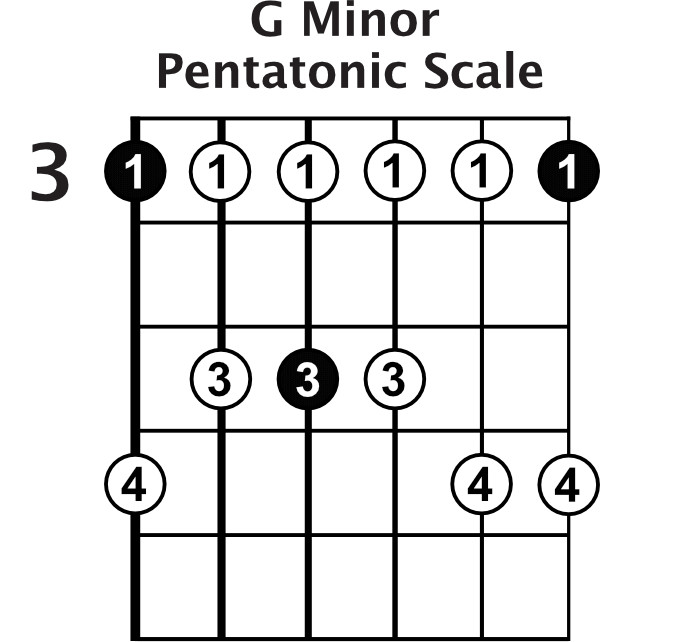 G Minor Pentatonic Scale Diagram
G Minor Pentatonic Scale Diagram
As you can see, the minor pentatonic scale initiates on the same root note as the major pentatonic shape but employs a different pattern of intervals. While both examples here are based on G, the G major pentatonic scale is derived from the key of G major, and the G minor pentatonic scale is derived from the key of G minor. The subtle but significant difference in note arrangement gives each scale its unique character and sonic flavor.
Download the provided jam track and dedicate time to practicing this minor pentatonic scale shape along with it. Proficiency in both major and minor pentatonic shapes is recommended before progressing further in this guide, as they form the foundation for more advanced techniques and concepts.
The 5 Essential Pentatonic Scale Shapes
By this point, you should be acquainted with two out of the five fundamental pentatonic scale shapes. These five shapes, when combined, encompass a span of twelve frets before repeating at higher octaves, and they seamlessly connect to one another across the guitar fretboard.
A helpful way to visualize this is to imagine all possible positions where you can play the five notes of the pentatonic scale across the entire fretboard. When you organize these positions systematically, you’ll discover five distinct shapes within a twelve-fret range. Mastering these five shapes unlocks the entire fretboard for pentatonic soloing.
Shape #1: The first shape should already be familiar to you as the major pentatonic scale shape we initially explored. Position one of the major pentatonic scale is based around an E major chord shape (in open position). If you compare the scale diagram to the E major chord shape, you’ll notice how they overlay and complement each other. The scale encompasses all the notes of the E major chord and incorporates additional notes that fit within the key, expanding your melodic possibilities.
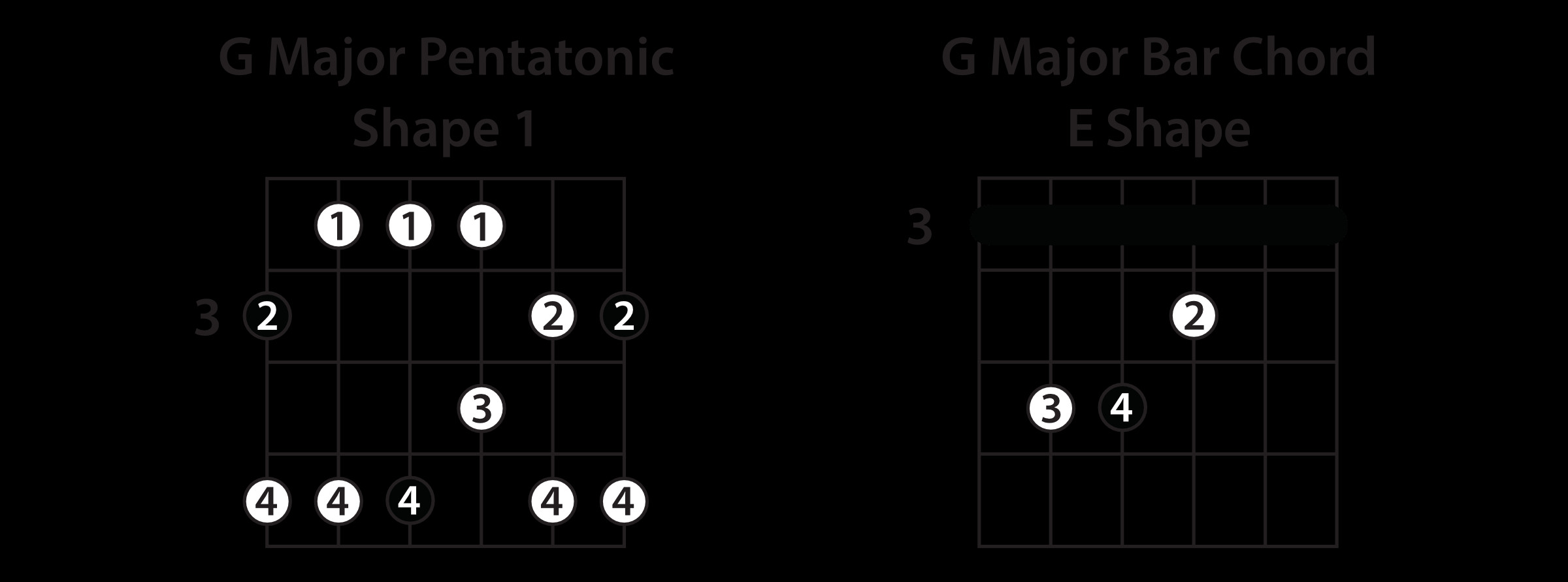 Pentatonic Shape 1 Diagram
Pentatonic Shape 1 Diagram
Visualizing underlying chord shapes within scale patterns is a highly effective learning technique. It not only aids in memorizing the scale shapes but also helps you identify the root notes and understand the harmonic context of the scale. This connection between chords and scales is crucial for improvisation and songwriting.
Shape #2: The second shape naturally follows on from where shape #1 concludes on the fretboard. Pay attention to the root notes within this shape, and you’ll observe that the scale pattern neatly outlines a D major shaped G major chord (referring to the barre chord shape based on open D major).
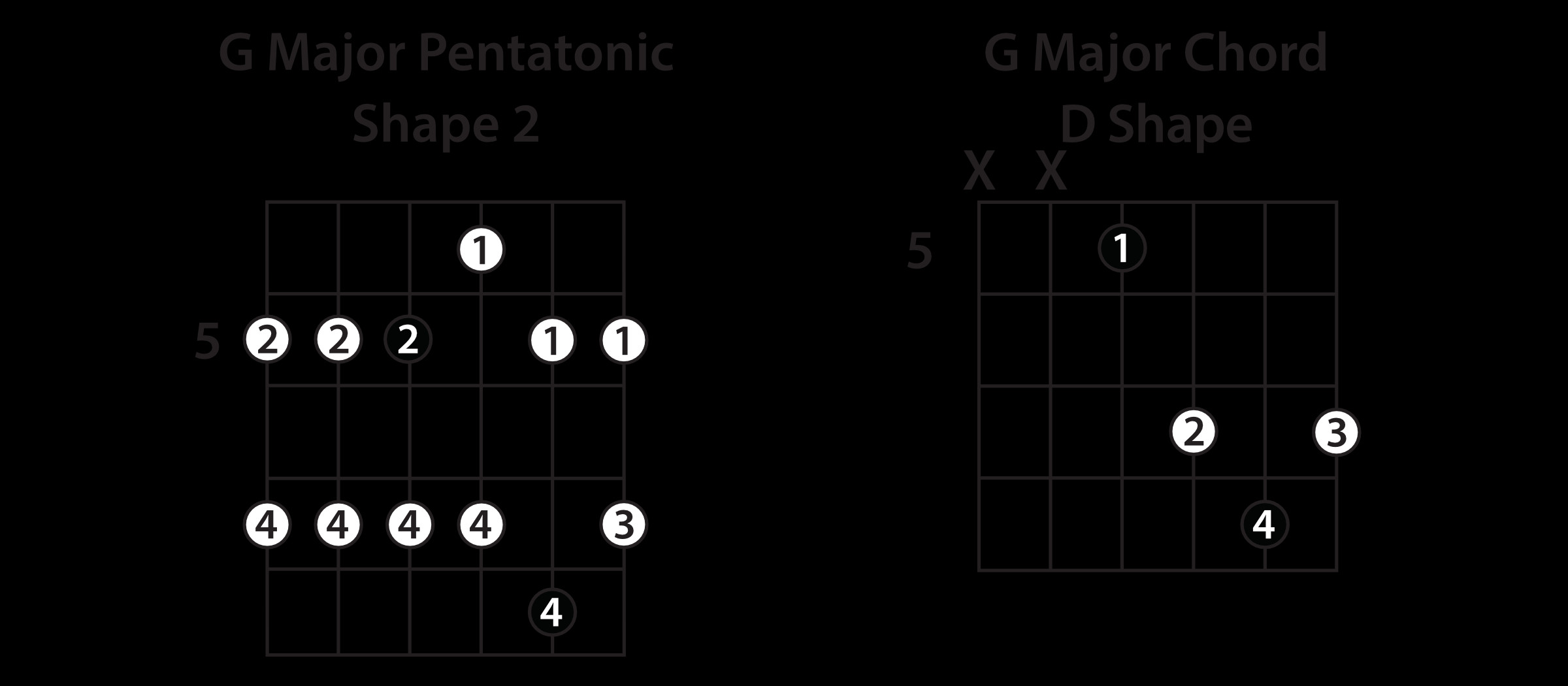 Pentatonic Shape 2 Diagram
Pentatonic Shape 2 Diagram
As you transition from one shape to the next, it’s crucial to focus on how each shape connects to its adjacent shapes. As your guitar playing progresses, you’ll naturally begin to move fluidly between these shapes, rather than remaining confined to a single position. This seamless navigation across the fretboard is key to fluent and expressive soloing.
Shape #3: Ascending further up the fretboard, we encounter a pentatonic shape that mirrors a C major shaped G major chord (again, referring to the barre chord shape derived from open C major). Remember, even as the shapes change, it’s still the same five-note pentatonic scale repeating across different octaves and fretboard positions. The G root notes are consistently marked as black circles, reinforcing that we are still exploring the G major pentatonic scale in its various forms.
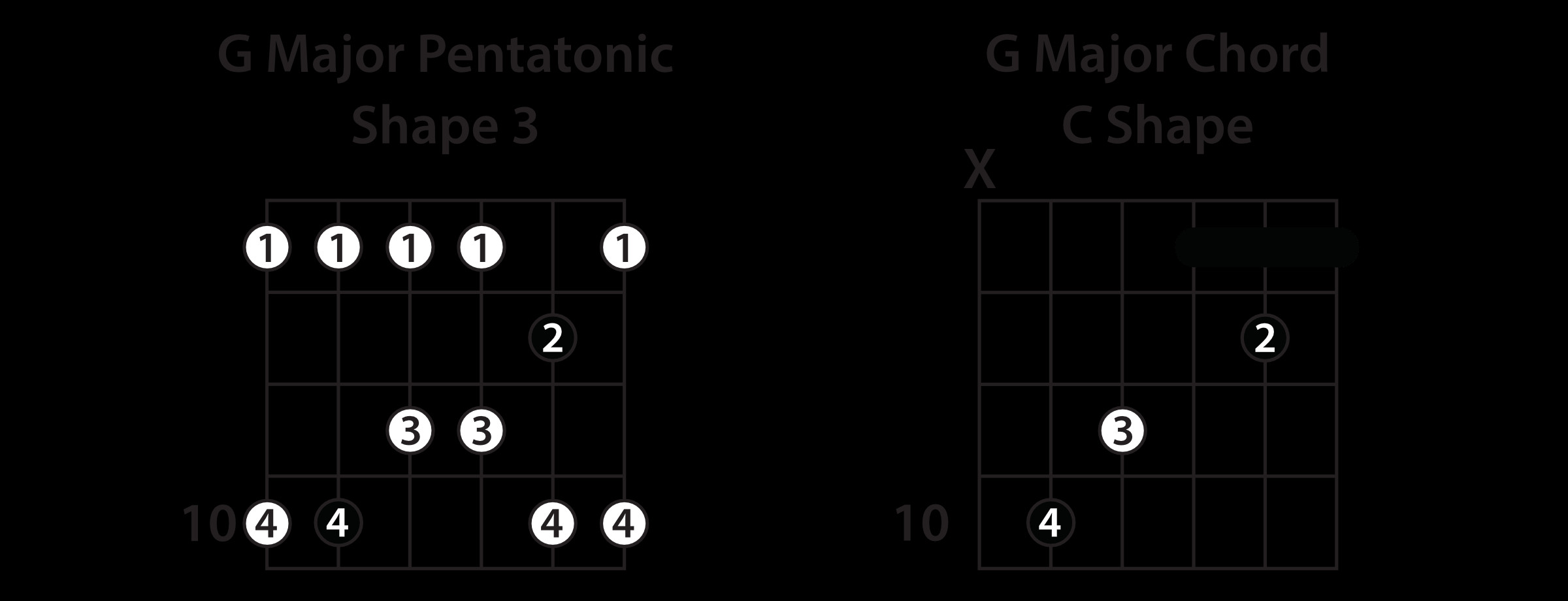 Pentatonic Shape 3 Diagram
Pentatonic Shape 3 Diagram
Shape #4: Here we have another shape that’s relatively easy to grasp and memorize. It features just two finger patterns stretched across the six strings and aligns with your standard A major shape bar chord. As with the preceding shapes, make sure to observe the connection points and overlaps between shape #3 and shape #4. Understanding these connections is vital for smooth transitions and fluid soloing.
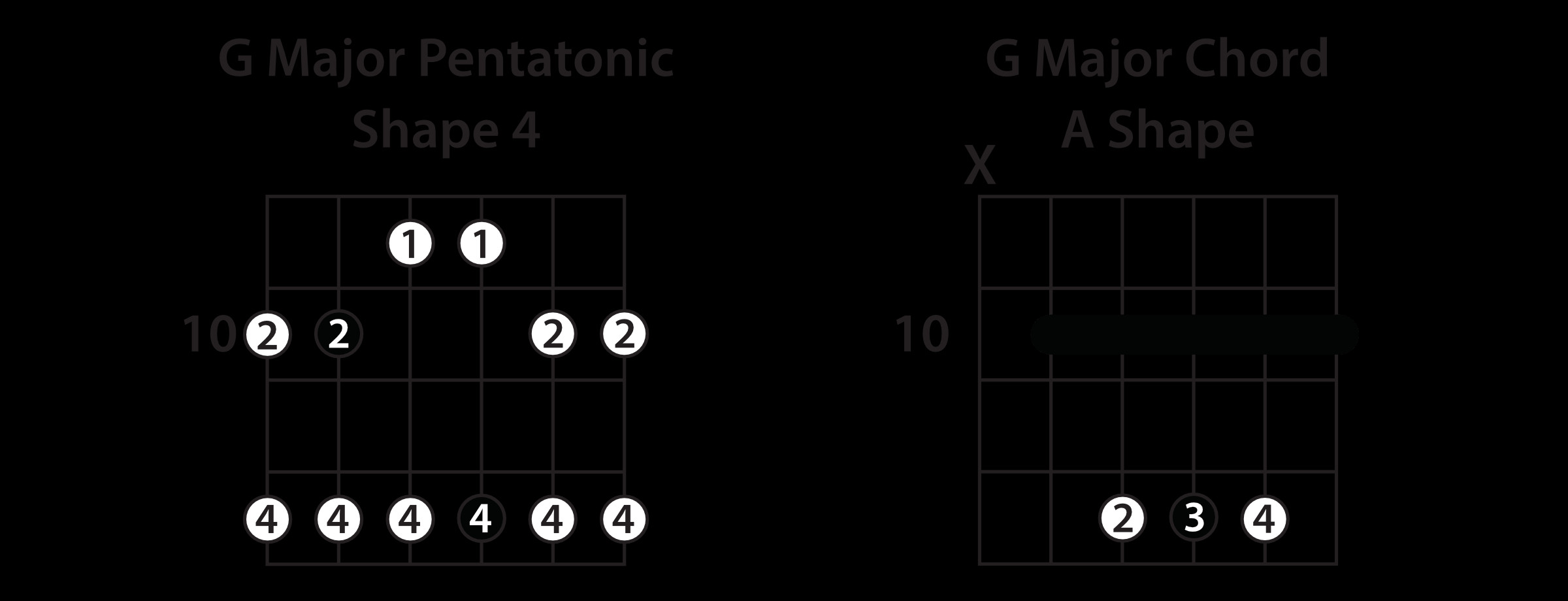 Pentatonic Shape 4 Diagram
Pentatonic Shape 4 Diagram
Shape #5: You might be wondering where the minor pentatonic scale shape fits into this sequence of five shapes. The minor pentatonic shape actually corresponds to the fifth and final shape in this interconnected series. You’ll notice that this shape visually differs slightly from the G minor scale shape we looked at earlier. This is because that initial G minor pentatonic shape was presented starting on the third fret to illustrate the root position of G minor. However, when integrated into the five-shape system within G major, this fifth shape, while visually similar to a minor pentatonic pattern, functions as part of the overall G major pentatonic scale and outlines a standard G major chord shape (barre chord based on open G).
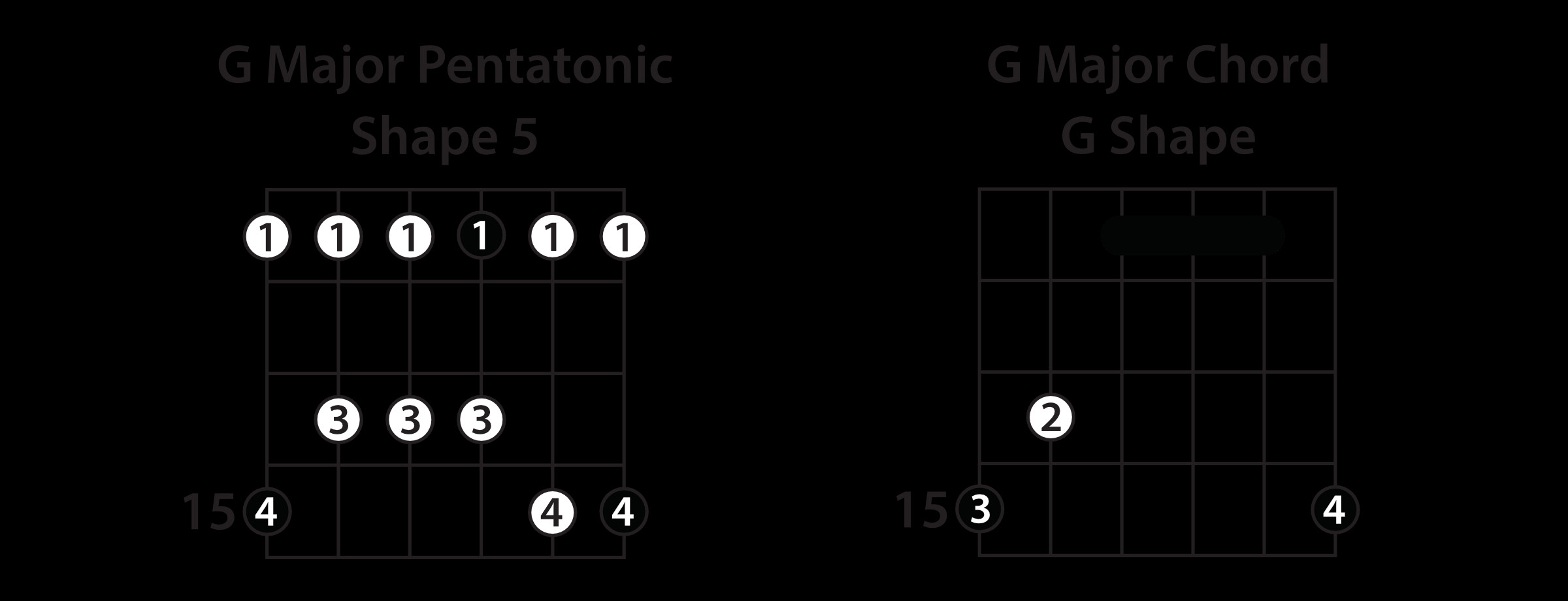 Pentatonic Shape 5 Diagram
Pentatonic Shape 5 Diagram
The Interplay Between Major & Minor Pentatonic Scales
Depending on your existing knowledge of music theory, you might already be familiar with the concepts of major and minor keys and their inherent relationship. If this is a new concept for you, let’s clarify with a brief explanation.
Every major key has a corresponding relative minor key. This relative minor key shares the exact same seven notes as its related major key. To find the relative minor key of any major key, you simply identify the sixth note of the major scale. This sixth note becomes the root note and name of the relative minor key. For example, in the key of G major, the sixth note is E. If you begin the same set of notes on E, you are playing in E minor. Here’s how it looks laid out:
G Major Scale: G A B C D E F#
Sixth Note: E
E Minor Scale: E F# G A B C D
As you can see, both scales comprise precisely the same notes, just starting from a different root. Consequently, they also share the same set of chords. This shared note content is why we use the term “relative.” This major and minor relationship directly translates to our pentatonic scales as well.
Therefore, the five G major pentatonic shapes you’ve learned are, in fact, identical in shape and position to the five E minor pentatonic scale shapes. The only distinction lies in how you perceive and emphasize the root notes. When playing in E minor using these shapes, you would consider E to be the root note, rather than G.
Here’s an E minor pentatonic scale diagram illustrating that it’s precisely the same shape and location as the fifth G major pentatonic shape we examined:
 E Minor Pentatonic Scale Diagram
E Minor Pentatonic Scale Diagram
When utilizing the minor pentatonic scale, it’s advisable to emphasize the root notes of the relative minor key (in this case, E) more prominently than the root notes of the major key (G). This means intentionally highlighting the E notes over the G notes when crafting your solos, lead lines, or improvisations to establish the minor tonality.
And that brings us to the conclusion of this guide on playing pentatonic scales on the guitar. You now possess a comprehensive understanding of all the major and minor pentatonic shapes and their interconnectedness across the fretboard. This knowledge is merely the starting point of your lead guitar journey. There’s a vast landscape of techniques and musical concepts to explore and enjoy. Continue scrolling for more guitar lessons to further your pentatonic scale mastery.
Further Guitar Lessons to Expand Your Pentatonic Skills
Pentatonic Navigation Tips: Connecting the Shapes
You’ve learned the five pentatonic shapes, but how do you seamlessly link them together to emulate the fluid phrasing of your guitar heroes? This lesson with Nate Savage unveils the interconnected pathways between the pentatonic scale shapes, enabling you to move effortlessly across the fretboard.
Minor Pentatonic Magic: Beyond the Box
Embark on an inspiring minor pentatonic exploration with Ayla Tesler-Mabe. Discover practical tips and techniques for breaking free from the confines of the standard pentatonic box shapes, allowing you to improvise guitar solos with greater feeling, expression, and originality.
The Ultimate Guide To Improvising Guitar Solos
Transform from a beginner to a guitar hero with this in-depth guide to improvising guitar solos. Starting with fundamental scale shapes and gradually progressing, you’ll learn the building blocks to create your own original solos spontaneously and confidently!
Ready to Accelerate Your Guitar Skill Development? Unlock Guitareo’s interactive practice tools and learn from world-class, inspiring instructors within our member’s area. Click the button below to begin your 7-day free trial today:
TRY GUITAREO FOR 7 DAYS
 Andrew Clarke Profile Picture
Andrew Clarke Profile Picture
Andrew Clarke is a seasoned guitarist, dedicated educator, and engaging content creator hailing from Vancouver, Canada. He is widely recognized for his popular YouTube channel, where he delivers easy-to-understand guitar lessons and informative gear reviews. Andrew is also the driving force behind The Riff, a platform for guitar enthusiasts.
